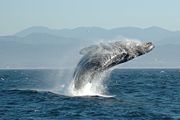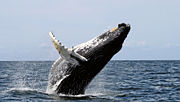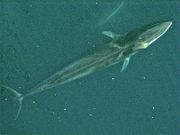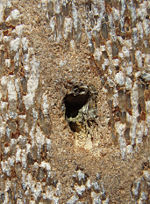Whale
2008/9 Schools Wikipedia Selection. Related subjects: Mammals
Whales are cetaceans which are neither dolphins (i.e. members of the families Delphinidae or Platanistoidae) nor porpoises. Orcas (Killer Whales) and Pilot whales have "whale" in their name, but they are dolphins for the purpose of classification.
The term whale is also sometimes used to refer to all cetaceans or just larger cetaceans.
Origins and taxonomy
All cetaceans, including whales, dolphins and porpoises, are descendants of land-living mammals of the Artiodactyl order (even-toed ungulate animals). Both cetaceans and artiodactyl are now classified under the super-order Cetartiodactyla which includes both whales and hippos. In fact, whales are the closest living relatives of hippos; they evolved from a common ancestor at around 54 million years ago. Whales entered the water roughly 50 million years ago.
Cetaceans are divided into two suborders:
- The baleen whales are characterized by baleen, a sieve-like structure in the upper jaw made of keratin, which they use to filter plankton from the water. They are the largest species of whale.
- The toothed whales have teeth and prey on fish, squid, or both. An outstanding ability of this group is to sense their surrounding environment through echolocation.
A complete up-to-date taxonomical listing of all cetacean species, including all whales, is maintained at the Cetacea article.
Anatomy
Like all mammals, whales breathe air into lungs, are warm-blooded, feed their young milk from mammary glands, and have some (although very little) hair.
The body is fusiform, resembling the streamlined form of a fish. The forelimbs, also called flippers, are paddle-shaped. The end of the tail holds the fluke, or tail fins, which provide propulsion by vertical movement. Although whales generally do not possess hind limbs, some whales (such as sperm whales and baleen whales) sometimes have rudimentary hind limbs; some even with feet and digits. Most species of whale bear a fin on their backs known as a dorsal fin.
Beneath the skin lies a layer of fat, the blubber. It serves as an energy reservoir and also as insulation. Whales have a four-chambered heart. The neck vertebrae are fused in most whales, which provides stability during swimming at the expense of flexibility. They have a pelvis bone, which is a vestigial structure.
Whales breathe through their blowholes, located on the top of the head so the animal can remain submerged. Baleen whales have two; toothed whales have one. The shapes of whales' spouts when exhaling after a dive, when seen from the right angle, differ between species. Whales have a unique respiratory system that lets them stay underwater for long periods of time without taking in oxygen. Some whales, such as the Sperm Whale, can stay underwater for up to two hours holding a single breath. The Blue Whale is the largest known mammal that has ever lived, and the largest living animal, at up to 35 m (105ft) long and 150 tons.
Whales generally live for 30-90 years, depending on their species, and on rare occasions can be found to live over a century. Recently a fragment of a lance used by commercial whalers in the 19th century has been found in a bowhead whale caught off Alaska, which showed the whale to be between 115 and 130 years old. Furthermore, a technique for dating age from aspartic acid racemization in the whale eye, combined with a harpoon fragment, indicates an age of 211 years for one male, making bowhead whales the longest lived extant mammal species.
Whale flukes often can be used as identifying markings, as is the case for humpback whales. This is the method by which the publicized errant Humphrey the whale was identified in three separate sightings.
Anatomy of the ear
While there are direct similarities between the ears of whales and humans, whales’ ears have specific adaptations to their underwater environment. In humans, the middle ear works as an impedance matcher between the outside air’s low-impedance and the cochlear fluid’s high-impedance. In aquatic mammals such as whales, however, there is no great difference between the outer and inner environments. Instead of sound passing through outer ear to middle ear, whales receive sound through their lower jaw, where it passes through a low-impedance, fat-filled cavity.
Behaviour

Whales are widely classed as predators, but their food ranges from microscopic plankton to very large fish. Males are called bulls; females, cows. The young are called calves.
As mammals, whales breathe air and must surface to get oxygen. This is done through a blowhole. Many whales also exhibit other surfacing behaviours such as breaching and tail slapping.
Because of their environment (and unlike many animals), whales are conscious breathers: they decide when to breathe. All mammals sleep, including whales, but they cannot afford to fall into an unconscious state for too long, since they need to be conscious in order to breathe. It is thought that only one hemisphere of their brains sleeps at a time, so that whales are never completely asleep, but still get the rest they need. This is thought because whales often sleep with only one eye closed.
Whales also communicate with each other using lyrical sounds, called whale song. Being so large and powerful, these sounds are also extremely loud (depending on the species); sperm whales have only been heard making clicks, as all toothed whales ( Odontoceti) use echolocation and can be heard for many miles. They have been known to generate about 20,000 acoustic watts of sound at 163 decibels.
Females give birth to a single calf. Nursing time is long (more than one year in many species), which is associated with a strong bond between mother and young. In most whales reproductive maturity occurs late, typically at seven to ten years. This mode of reproduction spawns few offspring, but provides each with a high probability of survival in the wild.
The male genitals are retracted into cavities of the body during swimming, so as to be streamlined and reduce drag. Most whales do not maintain fixed partnerships during mating; in many species the females have several mates each season. At birth newborn are delivered tail-first, minimising the risk of drowning. Whale cows nurse by actively squirting milk the consistency of toothpaste into the mouths of their young preventing loss to the surrounding aquatic environment.
Human effects
Whaling


Some species of large whales are endangered as a result of commercial whaling from the eleventh century to the twentieth. For centuries large whales have been hunted for oil, meat, baleen and ambergris (a perfume ingredient from the intestine of sperm whales). By the middle of the 20th century, whaling left many populations severely depleted.
The International Whaling Commission introduced a six year moratorium on all commercial whaling in 1986, which has been extended to the present day. For various reasons some exceptions to this moratorium exist; current whaling nations are Norway, Iceland and Japan and the aboriginal communities of Siberia, Alaska and northern Canada. For details, see whaling.
Several species of small whales are caught as bycatch in fisheries for other species. In the tuna fishery in the Eastern Tropical Pacific thousands of dolphins were drowned in purse-seine nets, until measures to prevent this were introduced. Fishing gear and deployment modifications, and eco-labelling (dolphin-safe or dolphin-friendly brands of canned tuna), have contributed to a reduction in the mortality of dolphins by tuna fishing vessels in recent years. In many countries, small whales are still hunted for food, oil, meat or bait.
Sonar interference
Environmentalists have long speculated that some cetaceans, including whales, are endangered by sonar used by advanced navies. In 2003 British and Spanish scientists suggested in Nature that sonar is connected to whale beachings and to signs that the beached whales have experienced decompression sickness. Responses in Nature the following year discounted the explanation. Mass whale beachings occur in many species, mostly beaked whales that use echolocation systems for deep diving. The frequency and size of beachings around the world, recorded over the last 1,000 years in religious tracts and more recently in scientific surveys, has been used to estimate the changing population size of various whale species by assuming that the proportion of the total whale population beaching in any one year is constant.
Despite the concerns raised about sonar which may invalidate this assumption, this population estimate technique is still popular today. Talpalar and Grossman argue that it is the combination of the high pressure environment of deep-diving with the disturbing effect of the sonar which causes decompression sickness and stranding of whales. Thus, an exaggerated startle response occurring during deep diving may alter orientation cues and produce rapid ascent.
Following public concern, the U.S. Defense department was ordered by the US circuit court in California to strictly limit use of its Low Frequency Active Sonar during peacetime. Attempts by the UK-based Whale and Dolphin Conservation Society to obtain a public inquiry into the possible dangers of the Royal Navy's equivalent (the " 2087" sonar launched in December 2004) have so far failed. The European Parliament on the other hand has requested that EU members refrain from using the powerful sonar system until an environmental impact study has been carried out.
Other environmental disturbances
Conservationists are concerned that seismic testing used for oil and gas exploration may damage the hearing and echolocation capabilities of whales. They also suggest that disturbances in magnetic fields caused by the testing may also be responsible for beaching.
Some scientists and environmentalists suggest that some whale species are also endangered due to a number of other human activities such as the unregulated use of fishing gear, that often catch anything that swims into them, collisions with ships. Toxins and the combination of toxins, particularly POPs (which concentrate up the food chain), are known to cause hearing loss by inhibiting the function of outer hair cells.
Whales are also threatened by climate change and global warming. As the Antarctic Ocean warms, krill populations, that are the main food source of some species of whales, reduce dramatically, being replaced by jelly like salps.



